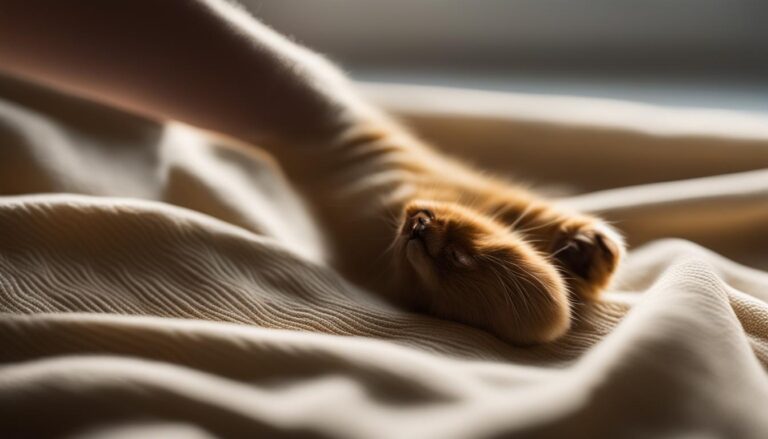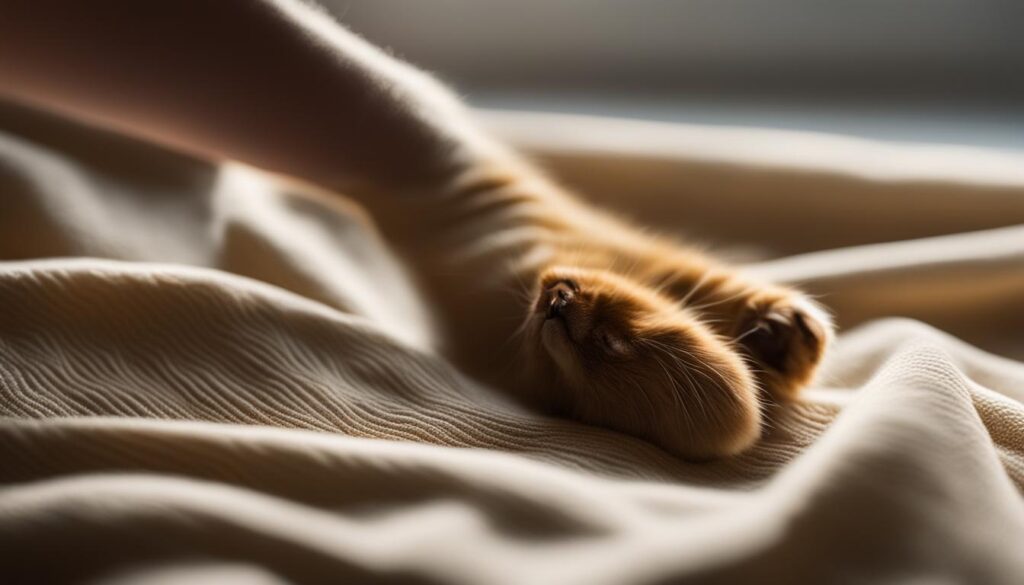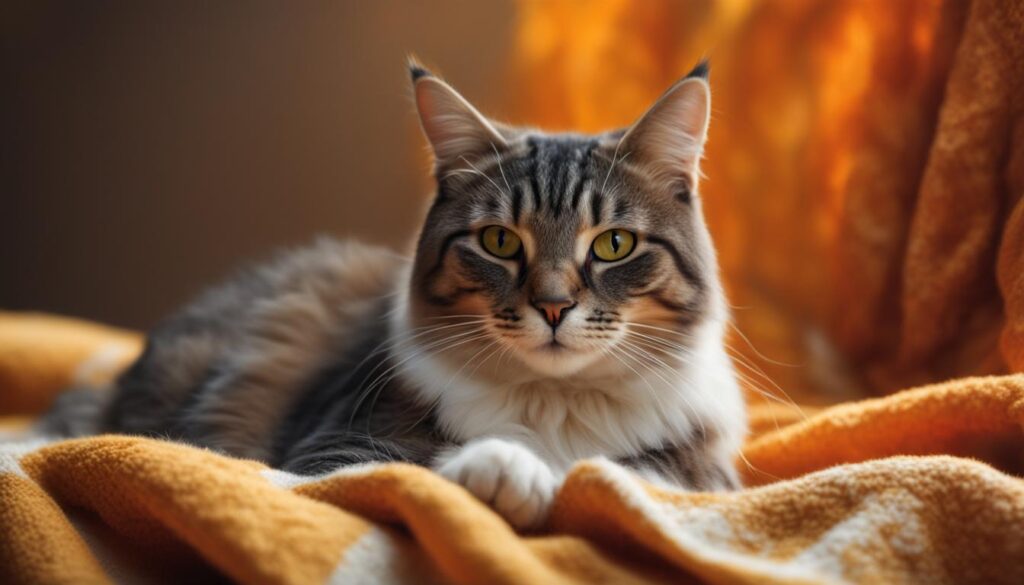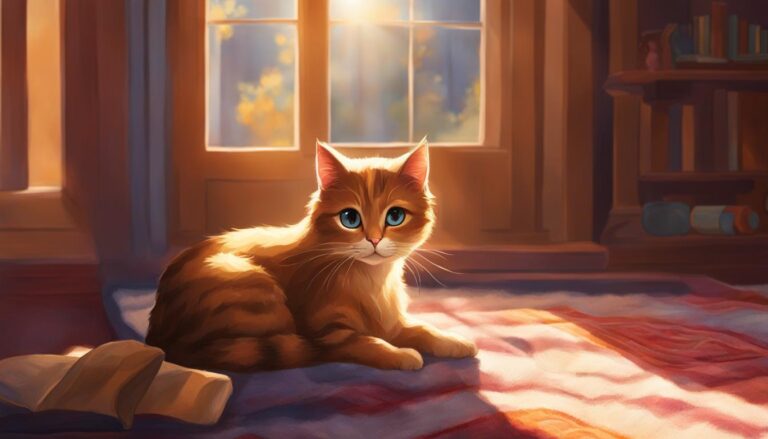Have you ever wondered why do cats knead or make biscuits on soft surfaces? This quirky behaviour has puzzled cat owners for years, but we’re here to shed light on the mysterious kneading habits of our feline friends. From their instinctual behaviours as kittens to marking territory and seeking warmth, there are several reasons why cats engage in this unique rhythmic paw movement.
Key Takeaways:
- Cats knead as an instinctual behaviour from their kittenhood, when they stimulated milk production by kneading their mother’s belly.
- Kneading serves multiple purposes such as marking territory, expressing contentment, stretching and flexing muscles, self-soothing, bonding, and seeking warmth and comfort.
- By kneading, cats release pheromones that act as scent markers, signalling to other cats that the area is safe and familiar.
- Kneading is often accompanied by purring and signifies a state of contentment and relaxation in cats.
- Engaging in kneading helps cats stretch and flex their muscles, promoting agility and physical well-being.
Table of Contents
Instinctual Behavior from Kittenhood
Kneading is an instinctual behaviour that originates from a cat’s early days as a nursing kitten. By using their paws to knead their mother’s belly, kittens stimulate milk production and ensure they receive enough nourishment. As they grow older, the instinct to knead remains, despite no longer relying on their mother for milk. Kneading is a remnant of their kittenhood and serves as a comforting and familiar action.
Kittens learn to knead as a survival mechanism, ensuring their well-being and development. This behaviour is deeply ingrained in their instincts, and even as adult cats, they continue to engage in this rhythmic motion with their paws. It is a natural reflex and a way for them to find comfort and security.
While the specific reasons for kneading may vary among cats, it is believed that the act serves multiple purposes beyond nursing. Some cats may knead as a way to mark their territory, leaving their scent on the surface they are kneading. Others may knead to express contentment and relaxation, as it has been associated with purring and a blissful expression. For many cats, kneading is simply a way to stretch and flex their muscles, promoting agility and physical well-being.

Marking Territory
When cats knead, they are not only engaging in comforting and familiar behaviour, but they are also marking their territory. Cats have scent glands on their paws, and as they knead, they release pheromones onto the surface they are kneading. These pheromones act as a scent marker, sending a message to other cats that the area is a safe and familiar space.
Kneading is a way for cats to establish ownership and create a sense of comfort and security for themselves. It’s their way of saying, “This is mine.” This territorial marking behaviour can be observed when a cat kneads on blankets, pillows, or even on their owners. By leaving their scent behind through kneading, cats are essentially claiming that space as their own.
Furthermore, the act of kneading is often accompanied by purring, which is another sign of contentment and relaxation in cats. So, when your furry friend kneads and purrs on your lap or a cozy blanket, they are not only marking their territory but also expressing their happiness and satisfaction in their environment.
| Kneading Behavior | Purpose |
|---|---|
| Releasing pheromones through the paws | Marking territory |
| Accompanied by purring | Expressing contentment |
| Creating a sense of comfort and security | Forming a safe and familiar space |
“Kneading is a way for cats to establish ownership and create a sense of comfort and security for themselves.”
So, the next time you see your cat kneading, remember that it’s not just cute and quirky behaviour. It’s a powerful way for them to communicate their presence, claim their space, and show their contentment. Embrace this kneading ritual as a sign of love, affection, and trust from your feline companion.

Expression of Contentment
Kneading is often associated with a cat’s contentment and relaxation. When cats knead, they often display a blissful expression and purr softly. This behaviour has been linked to a state of contentment and happiness in cats, indicating that they feel comfortable and safe in their environment. Kneading is a way for cats to express their contentment and well-being.
Kneading provides cats with a sense of security and fulfilment. The rhythmic motion of their paws on a soft surface releases endorphins, which are natural chemicals that promote relaxation and pleasure. It’s similar to how humans might enjoy a gentle massage or the sensation of kneading dough. For cats, the act of kneading triggers feelings of contentment, and the accompanying purring further reinforces their sense of calm.
It’s important to note that cats may also exhibit a biting behaviour while kneading, known as “love biting.” Although it may seem contradictory, this behaviour is typically a sign of affection rather than aggression. When cats become overly excited or stimulated during kneading, they may gently nibble or bite their owner’s hand. This behaviour is an instinctual response that stems from their natural inclination to play and interact with their littermates. It’s their way of expressing their affection playfully.
Stretching and Flexing Muscles
Kneading serves as a valuable form of exercise for cats, enabling them to stretch and flex their muscles. When cats knead, they engage their shoulder, back, and leg muscles, promoting flexibility and toning their bodies. This rhythmic motion helps to keep their muscles in optimal condition, ensuring agility and physical well-being. So, next time you catch your cat kneading away, remember that they are not only displaying their contentment but also taking care of their physical health.
In addition to maintaining muscle health, kneading also helps cats to keep their bodies supple. By regularly engaging in this behaviour, cats prevent their muscles from becoming stiff or tense. It allows them to retain their natural flexibility and range of motion, which is essential for their everyday activities such as jumping, climbing, and playing.
To visualize the impact of kneading on a cat’s muscles, we can compare it to the stretching exercises humans perform. Just as humans benefit from stretching to prevent muscle tightness and improve flexibility, cats achieve similar results through kneading. It’s their way of ensuring that their bodies remain agile and prepared for any physical challenges that may arise.
| Muscles | Benefits of Kneading |
|---|---|
| Shoulder Muscles | Promotes flexibility and range of motion in the front limbs. |
| Back Muscles | Strengthens the core and improves posture. |
| Leg Muscles | Enhances lower body strength and agility. |
As shown in the table above, kneading targets various muscle groups in a cat’s body, leading to overall muscle toning and conditioning. It’s fascinating to observe how this instinctual behavior serves not only as a means of communication but also as a way for cats to take care of their physical well-being.

Understanding the self-soothing nature of kneading is essential in ensuring the overall well-being and happiness of our feline companions. By recognizing the significance of this behaviour, we can provide our cats with the necessary environment and support to help them find comfort and relief from stress.
So, the next time you observe your cat indulging in this rhythmic act, appreciate their self-soothing ability and the comfort it brings to their lives.
Bonding and Trust
Cats are known for their independent nature, but they also form strong bonds with their human companions. One fascinating behaviour that showcases this bond is kneading. When your cat kneads on you, it’s a sign of affection and trust. They are expressing their love and associating the comforting feeling of kneading with your presence.
By kneading on your lap or chest, your cat is marking you as part of their territory, much like they would mark their mother during nursing. It’s their way of saying, “You belong to me, and I belong to you.” This bonding behaviour is a testament to the deep connection cats can form with their owners.
The act of kneading also releases endorphins in your cat’s brain, further enhancing their sense of relaxation and happiness. So, next time your feline friend starts kneading on you, take it as a compliment. It’s a clear sign of their affection and trust in you.
Overall, understanding the reasons behind your cat’s kneading behaviour can strengthen the bond between you and your feline friend. It’s important to respect their need for comfort and affection and provide them with a safe and secure environment. Remember, when your cat kneads on you, they are expressing their love and trust. Cherish these moments of bonding and enjoy the special connection you share with your furry companion.
Seeking Warmth and Comfort
Cats have an instinct for seeking warmth and comfort, and kneading is one way they fulfil this desire. When cats knead with their paws, they create a warm and cosy spot to settle down. By fluffing up blankets or soft surfaces, they prepare the area to make it inviting and comfortable for lounging or sleeping.
This behaviour also serves the purpose of marking the spot as their territory. By kneading, cats leave their scent on the surface, signalling to other cats that the area is claimed. It combines their need for comfort with their instinctual desire for warmth, creating a sanctuary that is uniquely theirs.
The act of kneading allows cats to indulge in their natural inclination for warmth and security. Whether it’s kneading a blanket, pillow, or your lap, this behaviour provides them with a sense of familiarity, comfort, and contentment. So, the next time your cat gets cosy and starts making biscuits, remember that they are simply creating a warm and comforting space for themselves.
Source Links
- https://blog.catbandit.com/why-do-cats-knead-and-bite-blankets-unraveling-the-feline-behavior/
- https://mybritishshorthair.com/why-do-cats-knead-your-hair-cat-knead-my-hair-and-drool-is-this-still-cat-love/
- https://stfrancisvilleanimalhospital.com/2023/09/does-your-cat-make-biscuits-heres-why-they-do/




